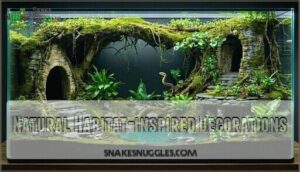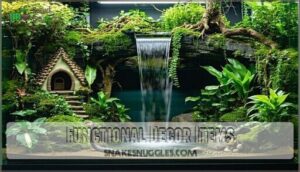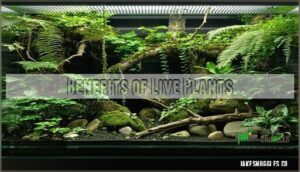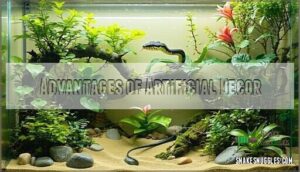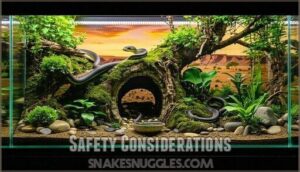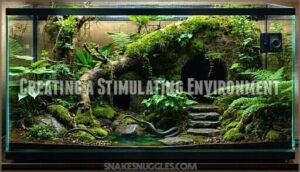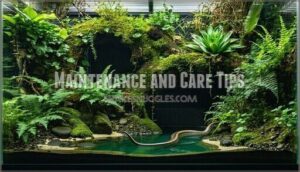This site is supported by our readers. We may earn a commission, at no cost to you, if you purchase through links.
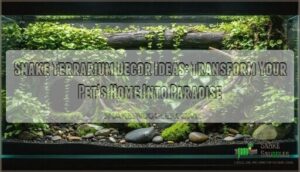 You’ll create a natural habitat that keeps your snake healthy and engaged with the right snake terrarium decor ideas.
You’ll create a natural habitat that keeps your snake healthy and engaged with the right snake terrarium decor ideas.
Start with essential hiding spots using hollow logs, rock caves, or commercial hides—your snake needs secure spaces on both warm and cool sides.
Add climbing branches for arboreal species and sturdy rocks for terrestrial ones.
Live plants like pothos or snake plants boost humidity naturally, while artificial options stay clean longer.
Focus on non-toxic materials and secure placement to prevent injuries.
The magic happens when you layer different textures, heights, and microclimates that mirror their wild environment perfectly, creating a natural habitat.
Table Of Contents
- Key Takeaways
- Essential Snake Terrarium Decor
- Types of Decorative Elements
- Live Vs. Artificial Decor
- Safety Considerations
- Creating a Stimulating Environment
- Maintenance and Care Tips
- Frequently Asked Questions (FAQs)
- How do you design a snake terrarium?
- Where can I buy snake terrarium decorations?
- How to choose a snake terrarium?
- What should a snake terrarium look like?
- What makes a snake’s terrarium a true home?
- What is a snake terrarium?
- How to decorate a snake terrarium?
- What to put in a snake terrarium?
- What decor do snakes like?
- What is the rule of thumb for snake enclosures?
- Conclusion
Key Takeaways
- Create essential hiding spots on both warm and cool sides – You’ll need secure retreats using hollow logs, rock caves, or commercial hides to reduce stress and encourage natural behaviors.
- Layer different textures and heights for enrichment – Mix climbing branches, sturdy rocks, and varied substrates to create microclimates that stimulate your snake’s mind and promote physical activity.
- Choose non-toxic materials and secure placement – You’ll prevent injuries by using safe woods like cork bark and ensuring all decorations are properly anchored to avoid collapse.
- Balance live and artificial elements for easy maintenance – Live plants boost humidity naturally while artificial options stay clean longer, giving you flexibility to create an engaging environment that fits your care routine.
Essential Snake Terrarium Decor
You’ll transform your snake’s terrarium from a basic cage into an engaging environment that promotes natural behaviors through thoughtful decor choices.
The right decorative elements serve three essential functions: enrichment to stimulate your pet’s mind, temperature regulation through strategic placement, and stress reduction by creating secure hiding spaces.
Enrichment
Snake enrichment transforms boring enclosures into engaging environments that meet your pet’s behavioral needs.
Think of it as creating a playground that keeps your snake mentally and physically active.
- Reduces stress through naturalistic setups with proper hiding spots
- Encourages natural behaviors like climbing opportunities and exploration
- Improves overall health via bioactive benefits and decor variety
Functional decor serves multiple purposes in your snake enclosure.
Temperature Regulation
Beyond enrichment, temperature control becomes your snake’s lifeline. Create a thermal gradient using heat lamps on one end and cooler zones on the other.
Position basking spots under your heat source, then use a thermostat to maintain precise thermostat settings. Heavy decorations naturally create temperature pockets throughout the enclosure.
To achieve ideal results, understanding temperature gradient principles is vital for snake health.
| Heat Sources | Temperature Range |
|---|---|
| Ceramic Heat Emitter | 85-95°F |
| Under Tank Heater | 80-88°F |
| Heat Lamps | 90-100°F |
| Radiant Heat Panel | 82-92°F |
| UVB Light | Ambient +5°F |
Stress Reduction
Beyond maintaining proper temperatures, creating calming environments is key for your snake’s mental health.
Hiding spots throughout the terrarium give your pet places to retreat when feeling overwhelmed. Think of these snake hideaways as stress-busters that mimic their natural habitat.
- Visual barriers using cork bark or artificial plants block sight lines
- Gentle lighting prevents harsh shadows that cause anxiety
- Reduced noise areas away from high-traffic zones
- Multiple hides at different thermal gradient points
- Basking spots with overhead cover for security while warming
Types of Decorative Elements
When you’re designing your snake’s home, you’ll choose from two main categories of decorative elements that serve different purposes.
Natural habitat-inspired decorations like cork bark and twisted vines recreate your snake’s wild environment.
Functional decor items such as water dishes and reptile caves combine beauty with practical benefits your pet needs to thrive, while also considering the snake’s overall well-being in its natural habitat.
Natural Habitat-inspired Decorations
Recreating your snake’s natural habitat transforms a basic terrarium into a thriving ecosystem. Think of yourself as a landscape architect designing the perfect home.
These naturalistic elements create authentic environments:
- Forest Floors – Layer dried leaves, moss, and bark pieces for woodland species
- Rocky Outcrops – Stack smooth stones to form caves and basking spots
- Desert Landscapes – Use sandstone and cacti for arid-dwelling snakes
- Water Features – Add shallow pools for humidity and drinking
Natural textures encourage instinctual behaviors while your reptile habitat decor mimics their wild surroundings perfectly. Proper reptile habitat decor selection is essential for creating an ideal environment.
Functional Decor Items
Smart terrarium decorations pull double duty—they look great and keep your snake healthy.
The best terrarium decor works overtime—beautiful displays that double as health boosters for your snake.
Water features provide hydration while boosting humidity levels. Reptile hides create cozy retreats that reduce stress and mimic natural burrows.
Climbing structures maximize vertical space, letting arboreal species stretch their muscles. Natural textures on reptile tank decor encourage normal behaviors like rubbing during sheds.
Choose functional decor that serves your snake’s biological needs while creating an eye-catching display. Proper reptile tank decor options can greatly enhance the overall environment with functional decor and reptile tank decor.
Live Vs. Artificial Decor
When choosing between live and artificial decor for your snake’s terrarium, you’ll need to weigh the benefits of each option carefully.
Live plants offer natural humidity control and oxygen production, while artificial alternatives provide durability and eliminate maintenance concerns.
Benefits of Live Plants
Live plants turn your snake’s home into a living ecosystem that works around the clock.
Transform your basic cage into a thriving ecosystem that breathes life into your snake’s world.
They boost Plant Humidity through natural transpiration while producing fresh oxygen—creating better air quality than artificial alternatives. Your snake gets Visual Stimulation from real textures and scents that encourage natural behaviors.
| Benefit | Impact |
|---|---|
| Oxygen Production | Improves respiratory health |
| Natural Aesthetics | Creates authentic habitat feel |
| Ecosystem Balance | Supports beneficial microorganisms |
| Terrarium Substrate | Plant roots stabilize soil structure |
Terrarium plants like pothos filter toxins while maintaining stable humidity levels. Bioactive elements create Natural Habitat conditions that reduce stress and promote wellbeing in your scaly friend.
Advantages of Artificial Decor
Artificial decor offers practical benefits that make terrarium maintenance a breeze. You’ll appreciate how these synthetic elements resist wear from heavy snakes and frequent handling.
| Feature | Benefit |
|---|---|
| Durability | Withstands years of use |
| Cleaning | Quick wipe-down sanitizing |
| Safety | No pesticide residues |
| Cost | One-time investment |
| Variety | Endless aesthetic options |
Artificial plants and reptile decor ideas provide consistent visual appeal without wilting or dying. Snake terrarium decor made from quality plastics maintains its structure, giving you complete control over your pet’s environment while ensuring long-term cost effectiveness and low maintenance requirements.
When designing a terrarium, considering thermal gradient options is essential for creating a comfortable and healthy space for your pet snake. This allows for a well-planned environment that meets the specific needs of your pet, making it a crucial aspect of terrarium maintenance and overall snake care, ensuring the well-being of your pet with complete control.
Safety Considerations
When decorating your snake’s terrarium, you’ll want to prioritize materials that won’t harm your pet if they decide to take a taste test.
Properly securing all decorative elements prevents potential accidents that could injure your snake or damage their home, which is a key consideration for maintaining a safe and healthy environment for your pet.
Non-Toxic Materials
Many snake owners overlook material safety, but choosing nontoxic materials protects your pet from harmful chemicals.
Safe woods and natural decorations create toxinfree environments that promote health while maintaining visual appeal.
- Natural Substrates – Aspen shavings and coconut fiber offer eco friendly options without aromatic oils
- Green Options – Cork bark and grape wood provide secure hiding spots free from toxic resins
- Safe Basking Spots – Food-grade ceramics and verified reptile plastics resist chemical leaching
- Sterilized Materials – Bake natural decorations to eliminate pathogens while preserving their safety
Secure Placement
Beyond choosing non-toxic materials, secure placement prevents your snake’s paradise from becoming a hazard zone. Weight distribution and anchor points matter—especially for arboreal species needing sturdy climbing structures.
| Safety Element | Key Considerations |
|---|---|
| Weight Distribution | Match decor size to enclosure capacity |
| Anchor Points | Secure branches and heavy items properly |
| Decor Stability | Test placement before adding your snake |
| Structural Integrity | Regular safety checks prevent accidents |
Accident prevention starts with matching decor to your snake’s habits and terrarium size for essential snake enclosure security. Ensuring proper escape proof construction is vital for the well-being of your pet snake.
Creating a Stimulating Environment
Your snake needs more than just food and water to thrive—it craves mental and physical challenges that keep its natural instincts sharp.
Creating climbing opportunities and adding sensory enrichment transforms a basic enclosure into an engaging habitat that promotes healthy behaviors and reduces boredom-related stress.
Climbing Opportunities
Creating vertical pathways transforms your snake’s home from flat to fantastic! Your pet craves climbing structures that mimic their natural world, giving them exercise and mental stimulation.
Incorporating reptile climbing wall systems can enhance their environment.
- Climbing branches – Use sturdy cork bark or driftwood pieces at different angles
- Rock formations – Stack flat stones to create natural ladder systems
- Vertical space maximizers – Install multi-level platforms using reptile caves as anchors
Sensory Enrichment
Your snake thrives on sensory enrichment through varied textures, natural scents, and visual stimulation.
Mix substrate types like cypress mulch with moss patches for tactile variety. Rotate safe wood scents weekly to trigger investigative behaviors.
Add dappled lighting through branches for cognitive challenges. These snake enrichment techniques transform basic snake terrarium decor into engaging natural decor that reduces stress and promotes active exploration behaviors. The result is a more natural environment that fosters a sense of investigative curiosity in your pet.
Maintenance and Care Tips
You’ll want to keep your snake’s paradise looking fresh and safe with regular maintenance checks.
Think of it like tidying up your own room – a clean terrarium means a happy, healthy snake that can show off its natural behaviors without any worries, in its own paradise.
Cleaning and Hygiene
Maintaining a spotless terrarium isn’t rocket science, but it requires dedication. Your snake’s health depends on consistent cleaning routines that prevent harmful bacteria and mold growth.
A vital aspect involves understanding temperature gradient importance for proper thermoregulation.
- Daily spot cleaning – Remove waste and uneaten food immediately
- Weekly deep clean – Disinfect all surfaces with reptile-safe solutions
- Monthly disinfection – Sterilize substrate and decorations thoroughly
- Quarterly substrate replacement – Fresh bedding prevents mold prevention issues
Monitoring Safety
Keep your snake’s sanctuary secure with routine safety checks.
Inspect each piece for material toxicity and decor stability issues that could spell trouble.
| Safety Check | What to Look For |
|---|---|
| Sharp Edges | Broken branches, cracked hides |
| Weight Limits | Overloaded shelves, loose fixtures |
| Rock Stability | Wobbly stones, unstable stacks |
Regular checks prevent accidents before they happen.
Test secure placement by gently nudging items—anything that moves needs anchoring.
Your snake’s behavior tells the story too.
Frequently Asked Questions (FAQs)
How do you design a snake terrarium?
Want total control over your snake’s world? You’ll mimic their natural habitat by choosing proper enclosure size, adding hiding spots, climbing branches, and maintaining correct temperature and humidity levels.
Where can I buy snake terrarium decorations?
You’ll find terrarium decorations at pet stores, reptile specialty shops, and online retailers like Amazon or Chewy. Look for non-toxic hides, climbing branches, and substrates designed specifically for reptiles.
How to choose a snake terrarium?
When the rubber meets the road, you’ll need to take into account your snake’s species, adult size, and natural habitat.
Choose an enclosure that’s at least two-thirds your snake’s length, with proper ventilation and easy cleaning access for long-term success.
What should a snake terrarium look like?
Your snake terrarium should mimic their natural habitat with proper hiding spots, climbing structures, appropriate substrate, stable temperature zones, fresh water, and secure decor that encourages natural behaviors.
What makes a snake’s terrarium a true home?
Studies show 70% of captive snakes exhibit stress behaviors when housed in bare enclosures.
You’ll create a true home by mimicking their natural habitat with proper heating, hiding spots, climbing structures, and appropriate substrates that encourage instinctual behaviors.
What is a snake terrarium?
A terrarium is your snake’s controlled indoor habitat that mimics their natural environment.
You’ll create the perfect home by balancing temperature, humidity, lighting, and hiding spots to keep your pet healthy and comfortable.
How to decorate a snake terrarium?
Creating the perfect habitat starts with mimicking nature’s blueprint. You’ll want to layer natural-looking substrates like cypress mulch, add secure hiding spots using cork bark or reptile caves, include climbing branches for vertical exploration, and provide a stable water dish.
Mix artificial plants with textured backgrounds for visual appeal while ensuring everything’s anchored safely, which is crucial for the habitat’s overall visual appeal.
What to put in a snake terrarium?
You’ll need hiding spots, water bowls, climbing branches, and substrate.
Add cork bark, artificial plants, and textured backgrounds.
Include heat sources, thermometers, and secure decor that won’t collapse or harm your snake, such as ensuring the environment has proper climbing structures.
What decor do snakes like?
Your snake isn’t picky about fancy aesthetics—it just wants comfort and security.
Provide hiding spots, climbing branches, water dishes, and natural materials like cork bark that mimic their wild habitat perfectly.
What is the rule of thumb for snake enclosures?
Measure your enclosure length and width, then multiply by the snake’s adult length. You’ll want at least that much floor space, but bigger’s always better for your slithery friend’s happiness.
Conclusion
Creating the perfect terrarium becomes a living canvas where every element serves both beauty and purpose.
Your thoughtful selection of snake terrarium decor ideas transforms a simple enclosure into a thriving ecosystem that mirrors nature’s complexity.
Remember that your snake’s well-being depends on balancing aesthetics with functionality—secure hiding spots, appropriate climbing structures, and safe materials create an environment where your pet can exhibit natural behaviors.
Regular maintenance keeps this carefully crafted habitat healthy, ensuring your snake enjoys a paradise that enriches both its physical and mental health.

